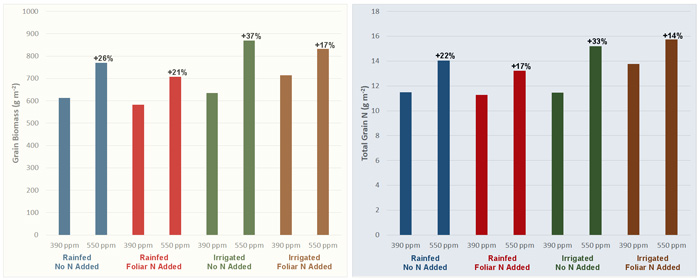| Follow @co2science |
Paper Reviewed
Sultana, H., Armstrong, R., Suter, H., Chen, D. and Nicolas, M.E. 2017. A short-term study of wheat grain protein response to post-anthesis foliar nitrogen application under elevated CO2 and supplementary irrigation. Journal of Cereal Science 75: 135-137.
Grain protein concentration is often assessed as an indicator of grain quality; and there have been a number of studies examining the impact of elevated CO2 on this parameter. The results to date are somewhat mixed, with some studies suggesting grain protein concentration will be depressed at higher levels of atmospheric CO2 and others showing no change or even increases. The most recent work to investigate this topic comes from Sultana et al. (2017).
Working at the Australian Grains Free-Air Carbon Dioxide Enrichment (AGFACE) site in Horsham, Australia, the team of five scientists grew spring wheat (Triticum aestivum, cv. Yitpi) outdoors under two CO2 levels (390 or 550 ppm), two N treatments (no application or foliar N applied one week after anthesis) and two levels of water supply (rainfed or irrigated) over the course of the growing season (190 days) in 2011.
In terms of growth, as shown in the figure below, elevated CO2 stimulated the grain biomass in each of the N and water supply treatments from 17 to 37 percent. With respect to grain protein, however, there was no statistically significant difference between the grain N concentrations at ambient or elevated CO2 levels under any of the N or water supply treatments. In contrast, elevated CO2 did increase (p < 0.060) the total N contents in the grains, from 14 to 33 percent, depending on N and water supply conditions.

Figure 1. Grain biomass (left panel) and total N content (right panel) of spring wheat (Triticum aestivum, cv. Yitpi) grown for 190 days under various combinations of CO2 (390 or 550 ppm), N treatment (no N or foliar added N), and water supply (rainfed or irrigated). The percentage difference in biomass due to CO2 is listed in black above each treatment. Source: Sultana et al. (2017).
In light of the above, it would appear that, in the future, elevated CO2 will increase the quantity of wheat grain yields without sacrificing their quality. And that is good news worth reporting!
Posted 7 November 2017



